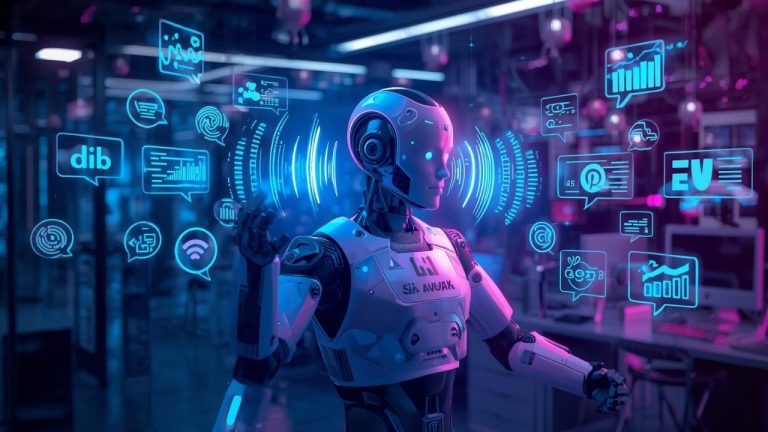
The internet is home to billions of web pages, videos, and articles — yet, when you search for something on Google, you usually get exactly what you’re looking for in seconds. Have you ever wondered how Google achieves this near-magical accuracy?
The answer lies in Artificial Intelligence (AI) and Machine Learning (ML) — two powerful technologies that have completely transformed how Google understands and delivers search results.
In 2025, AI is not just enhancing search — it’s redefining it. Google now relies on advanced AI models to interpret intent, personalize results, fight spam, and even predict what users will need next. Let’s explore exactly how Google uses AI and machine learning to power the world’s most sophisticated search engine.
- The Foundation: How Google Search Has Evolved with AI
When Google first launched in 1998, it was primarily a keyword-based engine. Its algorithm, PageRank, ranked websites based on the number and quality of backlinks. Back then, if your page had the right keywords and a few good links, you could rank easily.
But the internet grew rapidly — and so did user expectations. People stopped typing short keywords and began asking complex, conversational questions. Traditional keyword matching couldn’t keep up.
That’s when Google began integrating AI and machine learning models to understand search intent, context, and meaning — not just words. Today, every Google search involves multiple layers of AI systems working together to deliver the most relevant, high-quality results possible.
- RankBrain: Google’s First Big Step Toward AI Search
Introduced in 2015, RankBrain was Google’s first major leap into artificial intelligence. It uses machine learning to interpret and process search queries that Google hasn’t seen before — which, surprisingly, make up about 15% of daily searches.
Before RankBrain, Google’s algorithm could struggle with ambiguous or complex phrases. RankBrain changed that by focusing on semantic understanding — the meaning behind words.
Here’s how it works:
- It converts words and phrases into mathematical vectors that represent concepts.
- It then analyzes how these concepts relate to one another.
- Based on this understanding, it predicts which pages are most relevant to a query — even if the exact words don’t appear on the page.
For example, if someone searches “What’s the device that helps measure heart rate while jogging?”, RankBrain connects it with pages about fitness trackers or smartwatches, even if those words weren’t in the query.
In short, RankBrain helped Google think more like a human.
- BERT: Teaching Google to Understand Natural Language
While RankBrain focused on understanding words in context, Google’s BERT (Bidirectional Encoder Representations from Transformers) model, introduced in 2019, took comprehension to another level.
BERT allows Google to interpret the meaning of words based on all the surrounding words in a sentence, not just the ones that come before or after.
For instance, in the search “Can you get medicine for someone pharmacy?”, traditional algorithms might focus on “medicine” and “pharmacy.” But BERT understands that “for someone” changes the intent — the user wants to know if they can pick up a prescription for another person.
BERT was a milestone because it made Google capable of natural language understanding (NLU) — the same kind of contextual comprehension that humans use in conversation.
It meant Google could finally grasp the subtleties of language — prepositions, pronouns, and tone — and deliver more accurate results for long, conversational queries.
- MUM: Multitask Unified Model and the Future of Search
If BERT taught Google to understand language, then MUM (Multitask Unified Model) gave it the ability to think across languages, formats, and ideas.
Launched in 2021, MUM is 1,000 times more powerful than BERT. It doesn’t just understand language — it can also generate it.
Here’s what makes MUM revolutionary:
- It can process text, images, and even video simultaneously.
- It understands 75+ languages, allowing it to draw insights from global sources.
- It can perform multitask reasoning, meaning it can connect concepts from different domains.
For example, if you search, “I’ve hiked Mount Fuji — what should I do to prepare for Mount Kilimanjaro?”, MUM doesn’t just match words. It understands that both are mountains, compares conditions, gear needs, and altitude challenges, and suggests preparation guides, fitness tips, and local weather — all in one comprehensive response.
MUM brings Google closer to semantic search perfection — where results are based on meaning, not just matches.
- AI in Search Intent and Context Recognition
Google’s ultimate goal is to understand what you mean when you type — even if you don’t phrase it perfectly. AI makes this possible through:
- Query intent detection (informational, transactional, or navigational).
- Contextual analysis based on search history and behavior.
- Synonym and entity recognition, so “running shoes” and “sneakers” are treated as related.
Google uses machine learning classifiers to predict intent from query structures and refine results accordingly.
For instance, someone searching “best laptops 2025” is likely comparing products, while “buy laptop near me” signals purchase intent. AI ensures these two searches yield different kinds of results — one informational, one commercial.
- AI-Powered Personalization of Search Results
Beyond general ranking, Google personalizes results using machine learning algorithms that analyze individual user behavior.
This includes:
- Location data: Showing nearby stores or local service providers.
- Search history: Prioritizing topics or brands you’ve engaged with before.
- Device type: Displaying mobile-friendly pages on smartphones.
- Search habits: Adjusting results based on whether you prefer video, news, or blogs.
While personalization raises privacy debates, it ensures search results are uniquely relevant to each user. Google’s AI continuously learns from millions of data points to fine-tune this experience — so your results may differ completely from someone else’s.
- Fighting Spam and Low-Quality Content with AI
AI also plays a crucial role in maintaining the quality and integrity of search results. Google’s SpamBrain, an AI-based spam prevention system, detects and neutralizes manipulative SEO tactics such as keyword stuffing, link farms, and cloaked content.
SpamBrain constantly learns from new data patterns to identify even sophisticated forms of spam.
In addition to spam detection, AI helps Google evaluate content quality signals, including:
- Originality and expertise
- Readability and engagement
- Author credibility
- User feedback and dwell time
By analyzing these metrics, AI ensures that only trustworthy, relevant, and high-value pages rise to the top.
- AI in Visual and Multimodal Search
AI is also transforming how people search beyond text.
Through tools like Google Lens, users can search using images instead of words — for instance, snapping a photo of a plant to identify it or scanning a product to find reviews and prices.
This is powered by computer vision, a branch of AI that allows machines to interpret images just like humans.
Now, with MUM’s multimodal capabilities, Google can combine visual and textual data. For example, if you take a photo of your bike’s broken part and ask, “How do I fix this?”, Google can analyze the image, recognize the component, and provide step-by-step instructions.
This fusion of AI and visual search marks the next frontier of discovery — where words, images, and context converge seamlessly.
- Predictive and Conversational Search with AI
AI also powers predictive search — anticipating what users might need next. Features like Google Discover and autocomplete suggestions rely on deep learning models that analyze your activity, interests, and trends to surface relevant content before you even search for it.
Meanwhile, conversational AI (used in Google Assistant) lets users interact naturally, asking follow-up questions without repeating context. For instance:
- “Who won the World Cup in 2022?”
- Followed by: “Who was the top scorer?”
Google’s AI keeps track of the conversation flow, just like a human would — enabling truly dynamic and contextual search interactions.
- The Future: AI-Powered Search Beyond 2025
Looking ahead, Google’s AI ambitions go far beyond better search rankings. The company envisions search as an intelligent assistant — one that can understand emotions, anticipate needs, and integrate seamlessly across platforms.
We’ll see:
- Hyper-personalized search tuned to mood, behavior, and preferences.
- Voice and visual-first experiences, replacing typing altogether.
- AI-driven content summaries generated directly in search results.
- Continuous learning algorithms that evolve with cultural and linguistic changes.
In essence, Google is building a self-learning search ecosystem — one that evolves alongside humanity’s digital habits.
Conclusion: AI Is the Brain Behind Google Search
From RankBrain to MUM, AI and machine learning have revolutionized how Google understands the world’s information. They enable the search engine to interpret language, predict intent, personalize experiences, and maintain quality — all in real time.
Google’s search evolution is a masterclass in AI innovation. What once required manual indexing and keyword matching now happens through intelligent, self-improving algorithms that mimic human understanding.
As AI continues to advance, one thing is certain: search will become less about finding information — and more about understanding it.
In the future, every query will feel like a conversation, every result like an answer tailored just for you — all thanks to the power of AI.







